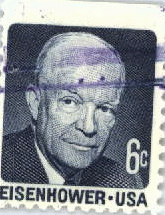 agreeing formally to recognize
the division of Korea and providing
for an exchange of prisoners. Some 20,000 North Korean and
Chinese prisoners of war, in the presence of Indian observers,
chose not to return to their homelands.
agreeing formally to recognize
the division of Korea and providing
for an exchange of prisoners. Some 20,000 North Korean and
Chinese prisoners of war, in the presence of Indian observers,
chose not to return to their homelands.
< Previous Page * Next Page >
President Eisenhower's first
administration opened on a
hopeful note. In July 1953, North Korea, faced with a military
stalemate, signed an armistice with the U.N. Command
 agreeing formally to recognize
the division of Korea and providing
for an exchange of prisoners. Some 20,000 North Korean and
Chinese prisoners of war, in the presence of Indian observers,
chose not to return to their homelands.
agreeing formally to recognize
the division of Korea and providing
for an exchange of prisoners. Some 20,000 North Korean and
Chinese prisoners of war, in the presence of Indian observers,
chose not to return to their homelands.
The Korean armistice did not end the troubles in Asia. By the spring of 1954 a coalition of Vietnamese Communists and nationalists clearly was winning its eight-year war against France's attempt to maintain its colonial rule over Indochina. From May to July representatives of France, the Soviet Union, Great Britain, the United States, and several Asian nations met at Geneva to discuss ending the fighting. The conferees divided what had been called French Indochina into three nations: Cambodia, Laos, and Vietnam-with Vietnam temporarily divided at the 17th parallel into northern and southern administrative districts pending unification elections scheduled for July 1956. In its final declaration the conference recognized the sovereignty, independence, and territorial integrity of Cambodia, Laos, and Vietnam. The election mandated by this Geneva conference was never held, in part because it was feared the nationalist-Communist leader, Ho Chi Minh, would come to power through subversion of an electoral process he did not support.
Against this background of conflict, in September 1954, the United States joined with Thailand, the Philippines, Pakistan, Great Britain, France, Australia and New Zealand to establish the Southeast Asia Treaty Organization. SEATO, as this mutual-assistance pact was called, provided for economic cooperation, technical assistance, and collective action against aggression or subversion. An attached clause extended the original treaty provisions for protection and economic aid to Laos, Cambodia, and South Vietnam.
In addition, the United States expanded its technical assistance program for Asia, the Middle East, Africa, and Latin America. By 1958, following $1,000 million spent for relief and reconstruction from the U.S., South Korea surpassed its prewar production and consumption levels. Equally effective was the massive assistance given the Philippine Republic to help rebuild after the ravages of war and to support its fight against guerrillas. Altogether, between 1950 and 1960, the U.S. provided more than 60 nations with machinery, medicines, loans, and technicians.
< Previous Page * Next Page >